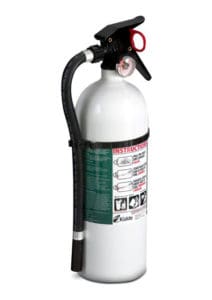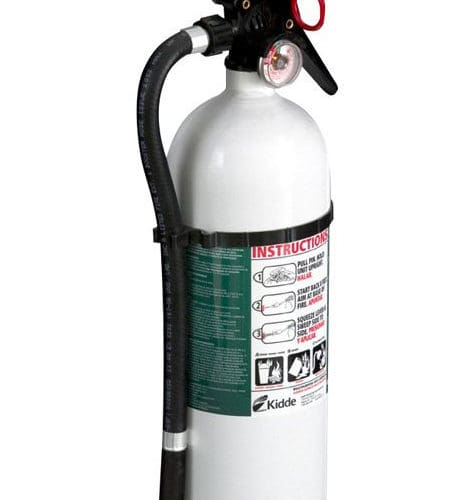Fire! It’s a scary enough thought while ashore. Just imagine cowering in the cockpit of your boat, staring down the companionway as ugly black smoke starts to pour out. What do you do now? If you don’t have an answer, think the problem through before you head offshore again.
Aside from any knowledge of firefighting techniques, there are three basic steps that will make it much less likely to have to abandon a vessel because of fire. First and most important is to take all action possible to prevent a fire from starting. Second, prepare yourself for fighting the fire before one starts. Third, communicate with the other people aboard while fighting the fire.

A fire needs three elements to remain burning: heat, oxygen and fuel. This is the so-called fire triangle. Remove one of these three legs of the triangle and the fire will no longer be able to sustain itself. Simplified, this seems straightforward: add heat and oxygen (which is all around us in the air) to a fuel source and we get a fire. There are also chain reactions that transform the heated vapor/oxygen mixture into fire and smoke. This chain reaction changes the fire triangle into a fire tetrahedron, a four-sided figure. It also provides another area for attack when trying to extinguish the flames. Successfully fighting a fire requires that one of these four elements be removed: either heat, oxygen, fuel or the chain reaction.
Solid fuel does not actually burn. The fire is being fed by a vapor that the fuel gives off once it has been sufficiently heated. The temperature at which a fuel gives off enough vapor to create a flammable mixture with the oxygen in the air is called the fuel’s “flash point.” In order to burn, a fuel must be at or above the temperature of its flash point. The flash point of gasoline is around -45° (all temperatures are in Fahrenheit), while diesel fuel has a flash point near 110°.
The flash point should not be confused with the “ignition temperature” of a fuel. The ignition temperature is the lowest temperature at which the fuel will sustain fire without the application of an external flame or spark.
The ignition temperature for most petroleum products falls between 490° and 765°. For most fats, cooking oils and greases the temperature is between 650° and 750°. The ignition temperature for wood is relatively low at 450° to 520°. The ignition temperature of fiberglass depends on the type of resin used. While the glass itself burns only at very high temperatures, a standard polyester resin has an ignition temperature close to 400°.
Another possible problem on boats is spontaneous combustion or ignition. Often this occurs when heat is generated by a slow oxidation process. As the heat increases, the oxidation process accelerates. This spiral continues until the heat reaches the ignition temperature and fire erupts. Many materials are subject to spontaneous ignition. The ones most commonly found on yachts are animal or vegetable oils that are discarded as waste. The problem occurs when this waste is stored temporarily in or near an engine or generator compartment, both sources of heat.
Now that we have a more sophisticated view of fire components, let’s take a look at some ways to prevent fire from starting. The easiest fire to deal with is one that never starts. On top of the list is good housekeeping. A clean vessel will be much less susceptible to fire than a disorderly, dirty one. There are many flammable liquids stored on most yachts. Paints and solvents should be kept in clean, well-sealed containers. And these cans should be stowed so that they will not fall and spill in rough conditions. Keep flammable liquids, including any gas tank for the dinghy, stored in a deck locker or deck box — not belowdecks. Dirty, oil-soaked rags should similarly be isolated until they can be cleaned.
Keep the engine area and bilges clean and free of leaked oil or diesel fuel. Any leak or spill will be much more evident in a clean area than in one already spattered or smeared with oil. One of the most dangerous fires is a broken or leaking diesel hose or connection that allows the fuel to pour onto a hot part of the engine. This type of problem ensures a constant source of fuel as well as heat. Because the engine, and generator if it exists, may only be checked once or twice each day, it is important that any problem be as apparent as possible.
The galley is another danger area. Cooking takes place over an open flame. This provides a ready heat source. The fuel may be supplied by grease or oils used in cooking and these will often ignite without being brought in contact with the flame. Preventing these grease fires is a matter of conscientious cooking practices. Also, people unfamiliar with the stove operation may apply too much fuel, generating a huge flame. Make sure that everyone aboard is trained in operating the stove.
Despite training, however, accidents can happen. Try to avoid having loose porthole curtains or other flammable materials over the stove — in the case of a flare-up those could spread the fire. It’s possible that the stove may be left “on” without a flame, thus allowing fuel to escape into the boat. This is very dangerous as many stoves use fuel that is heavier than air and if they leak the fuel will collect in the bilge.
Smoking is another hazard. Some boats limit all smoking to above deck. This keeps the danger of fire from matches and cigarettes out of the hull itself. Additionally, in the event of an unexpected wave where the smoker loses balance, it is less likely for a lit cigarette to land on burnable cushions or other belowdecks upholstery. Smoking belowdecks while underway provides opportunities for ashtrays with lit cigarettes to hit the deck. Smoking in a berth is as foolish as smoking in a bed; it’s an invitation for a fire.

